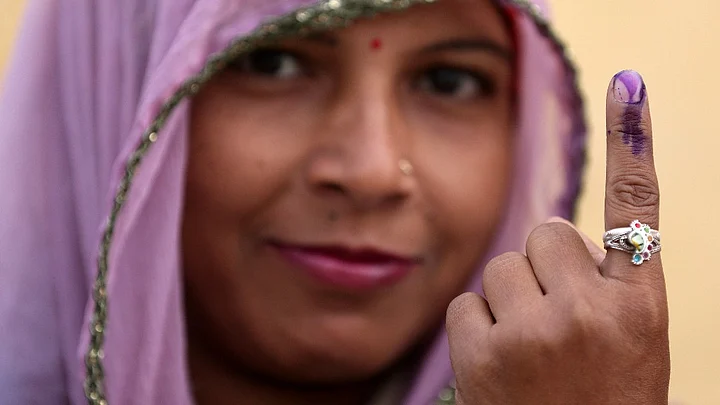Kaun Banega Pradhanmantri? (Who will become the Prime Minister)?
The frequently asked question greets you whether you are in newsrooms, in family conversations, with friends, among share-market participants or at political rallies. Nobody has the answer except opinion poll pundits. And if we follow the recent polls, we are made to believe that Bharatiya Janata Party-led NDA is coming back to power, albeit with slightly reduced strength.
Should we believe these numbers? You can, if you are a compulsive risk taker and are willing to accept that even the smallest sample size of electorates can enrich you with information significant enough to make definitive poll projections. However, the quality of data collected and analysed by pollsters does not inspire confidence.
Let us analyse three recent polls — Times Now-VMR, ABP News-C Voter and India TV-CNX. There is a remarkable similarity in the findings of the three polls. According to their projections, the NDA is set to get 267-289 seats, with a vote share in excess of 40 percent.
Big Projections Based on Feedback From a Handful of Voters
However, how were these grand conclusions arrived at? Times Now-VMR arrived at the big number by talking to 14,301 people across 960 locations. This works out to an average of 26 voters in each of the 543 Lok Sabha constituencies. Is it even adequate by any stretch, if we consider that the average size of the electorate in each Lok Sabha seat is nearly 16.5 lakh? Even if sampling is perfect and votes to seats projection statistically flawless, can such a tiny sample size reflect the mood of the entire constituency?
The sample size of India TV-CNX is slightly higher at 38,600. But it conducted its poll in only 193 of the total 543 Lok Sabha seats and yet made projections for all the seats. Does that make sense? We do not know which 193 seats were selected and which ones were ignored. Did the poll cover all the states and union territories? Since there is no vote share projection given, we don’t know how votes were converted into seats.
ABP News-C Voter, on the other hand, had the largest sample size at 45,134 among the three polls. This too works out at 83 voters, on an average, in a Lok Sabha constituency. Is that enough to make big projections? However, C Voter poll seems to be the most representative of the three.
Projection in States Which Switched Sides Recently
All the three polls project a total reversal of what we saw in Madhya Pradesh, Rajasthan and Chhattisgarh only a few months ago. The polls reckon that the Congress is facing total rout in these states despite winning them in November-December last year. Polls project the BJP winning 20 out of the 25 seats in Rajasthan, 23 out of the 29 seats in Madhya Pradesh and a majority of seats in Chhattisgarh.
That may well be the case. But the analysis of past elections suggests that results of the Lok Sabha elections held within six months of the Assembly elections mirror each other. Did the opinion polls find out something unusual suggesting complete reversal in the three states in just four months? If they have, they should let us know.
Crucial State of Uttar Pradesh
While the C Voter poll predicts a loss of 41 seats for the NDA in Uttar Pradesh, the Times Now-VMR poll projects a loss of 23 seats for the BJP. The latter gives a vote share which is higher than what the BJP and its allies got in the 2014 Lok Sabha elections. It suggests that the SP-BSP-RLD alliance is not going to be vote accretive and the combine is likely to witness erosion of its support base. This is perhaps the first poll that says so. Reports from the ground, however, suggest otherwise.
It is pertinent to add that Uttar Pradesh has been going through a phase of unprecedented democratic upsurge. The state has given four different verdicts in the last five elections. Given this background, will the BJP and its allies be able to buck double incumbency, both at the Centre and in the state, and improve on its vote share achieved five years ago?
100 Percent Record to Be Maintained in Some States
According to India TV-CNX poll, the BJP is expected to do an encore in Gujarat, Uttarakhand, Himachal Pradesh and Delhi by winning all the seats on offer. And the party is set to better its performance in Assam, Haryana, Odisha and West Bengal. Moreover, the BJP is likely to win 22 out of 24 seats it is contesting in Maharashtra and 15 of the 17 seats in Bihar. It will be a miracle if 100 percent record is maintained in two consecutive elections, a first perhaps in several decades.
Wonder why ground reports have failed to capture the coming tsunami while opinion polls have.
The three polls have suggested that the NDA’s chances of coming back to power have improved following the air strikes in Pakistan. However, we leave you with the findings of yet another survey to draw your own conclusion.
India's Balakot air strikes inside Pakistan conducted less than two months ago, no longer influence voters ahead of the Lok Sabha elections, an India Today survey has found. "Instead, unemployment is a major issue for 21 percent of the electorate, followed by drinking water (20 percent), cleanliness (9 percent) and inflation (8 percent), according to the poll conducted by Axis-My-India for India Today's Political Stock Exchange (PSE). The survey returned a zero-percent response on the question of the 26 February air strikes impacting voting decisions,” India Today reported.
(At The Quint, we question everything. Play an active role in shaping our journalism by becoming a member today.)




